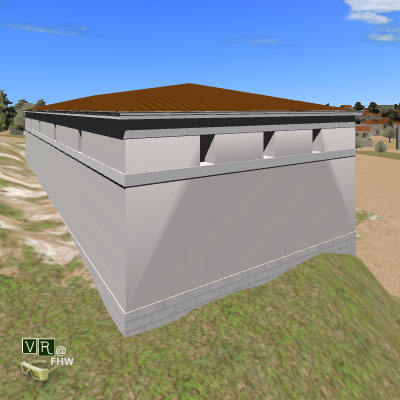Location: North of the hill of Agoraios Kolonos, and N of the Temple of Hephaestus. (after Mc CAMP II, J., The Athenian Agora: A Guide to the Excavation and Museum, 4th ed., Athens 1990. p. 46, no.2.
Date of Construction: Early 3rd cent. BC
Periods of Use: Hellenistic
INTRODUCTION
This very badly ruined building north of the hill of Agoraios Kolonos is identified as a Hellenistic arsenal.
Building’s description
This structure is situated north of the hill of Agoraios Kolonos, close to the Temple of Hephaestus. It was excavated by Dorothy Thompson in 1936, and by Homer Thompson in 1937. Its identification as a hypothetical “arsenal” (a storage room, that is, for weaponry and military equipment in general) resulted from the comparison of its shape to similar buildings, like the famous Skeuotheke of Philo in Piraeus, as well as by the discovery of the records of the Athenian cavalry in a nearby well. The fact that it neighbours buildings which housed bronze-working workshops, but also the Temple of Hephaestus, reinforces this identification.
The dating of the building is based of the pottery unearthed in three adjacent reservoirs. The earlier dating of around 310-290 BC has been recently re-evaluated. Today it is thought that the building was erected in the period between 290 and 260 BC. Furthermore, we might be able to date the start of its use with even greater accuracy, if we take it to be the seat of the Treasurer for the Military, an office which at the period had acquired renewed significance, as the Athenians were engaged in military conflicts in areas of Greece. After a long period of obscurity, the Treasurer for the Military is mentioned again in an important Attic inscription dating to 273/272 BC. If we accept the building’s association with the Treasurer for the Military, then we must accept that this was also used as a storage place for various other objects and implements, given that the said official oversaw the construction of the Nikes for the Panathenaea, as well as the distribution of the olive oil to the winners of the Panathenaic Games, which was previously stored in the Pompeion. Plentiful finds of Hellenistic Panathenaic amphorae discovered in the surrounding area also support this hypothesis.
The building survives in a very poor condition: of its foundation, only a few cornerstones survive on the SE and NW corners. We have, however, a -more or less- clear picture of its ground plan thanks to the chiselling that remains on the rock and by its comparison with similar buildings, such as the Skeuotheke of Philo in Piraeus. It was a large rectangular structure measuring 17.62 x 44.4 m, of an NW-SW orientation, its façade facing an ancient street. On the inside there were two rows of eight columns or pilasters, which divided the space in three aisles of approximately equal length. Apparently there was only one door, in the western end of the building’s façade.
The building was probably destroyed during the capture of Athens by Sulla’s troops in 86 BC. As no signs of fire were discovered, it is assumed that the Roman soldiers simply dismantled the roofing to use the precious timber in the siege of Acropolis. It was never replaced by another building, and it was used a source of building material.
Water supply
A system of reservoirs was excavated in the surrounding area, which supplied water to the building. One of the reservoirs, called ‘the Egyptian’ because of the remnants of faience artefacts it contained, was located in the SW corner of the building. It consisted of two rooms and it was apparently created immediately after the Arsenal’s construction. The second reservoir, which also consists of two rooms, was situated in the middle of the building’s north side. A third reservoir was discovered in the NE edge, which was dubbed “the Cavern”. This one appears to have been rendered useless during the construction activities for the building, and its contents provide a reliable basis for its dating.
BIBLIOGRAPHY
Mc CAMP II, J.,
The Athenian Agora: A Guide to the Excavation and Museum, 4th ed., Athens 1990. p. 45.
Mc CAMP II, J.,
The Athenian Agora: Excavations in the Heart of the Classical City², Cambridge University Press 2001, pp. 201-202.
EDWARDS, G.R., “Panathenaics of Hellenistic and roman Times”,
Hesperia 26, 1957, σελ. 320-349, table 76-88 (esp. pp. 334-337).
ΟΡΛΑΝΔΟΣ, Α.Κ.,
Η Ξυλόστεγος Παλαιοχριστιανική βασιλική της Μεσογειακής Λεκάνης Ι, Athens, 1954, pp. 64-67.
POUNDER, R.L., “A Hellenistic Arsenal in Athens”,
Hesperia 52, 1983, pp. 233-256, table 49-50.
RUMPF, A., «Der Westrand der Agora zu Athen»,
JDI 53, 1938, pp. 117-138.
THOMPSON, D.K., “The Garden of Hephaistos»,
Ηesperia 6, 1937, pp. 396-425 (esp. pp. 397-400).
THOMPSON, H.A., WYCHERLEY, R.,
The Agora of Athens. The American Excavations in the Athenian Agora, vol. XIV, American School of Classical Studies at Athens, Princeton 1972, pp. 80-81.
WYCHERLEY, R., “The Stoa Basileios”,
JHS 60, 1940, pp. 95-96.
WYCHERLEY, R., “The North-West Stoa of the Athenian Agora”,
JHS 68, 1948, pp. 152.

Arsenal, Representation in VR environment

